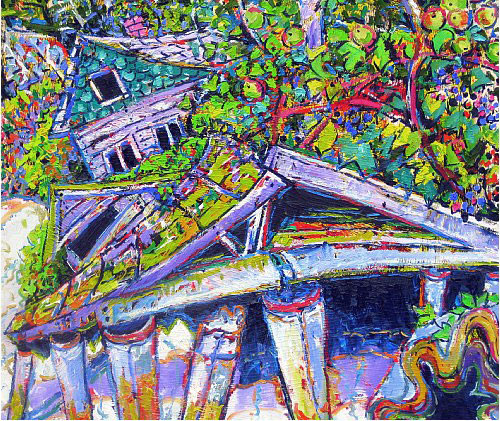Kurlakues is in the Broughton Achipeligo on the north end of Vancouver Island Marine Link makes a lot of side trips so the tourist can wander the beaches of some isolated islands where very few humans have set foot. The islands are so blasted by winter storms they have never been logged, the timbers is twisted and gnarled only good for fire wood or nesting sites for eagles. The paintings is featured on page 54 of Book #3 40 Paintings and stories of the working coast. – Acrylic on Canvas
$3,450.00
36″x40″
Acrylic on canvas.
| Dimensions | 30 × 40 in |
|---|
1 in stock
Description
Kurlakues
36″x40″
Acrylic on canvas.
The Inspiration
As the Aurora Explorer rounds the point into the Karlukwees, the classic white clam shell beach stands out. The slope of the beach was important in a dugout canoe culture. Also crucial was a year round source of fresh water. These islands had all these necessary features.
Apple, pear, cherry trees are always signs of past homesteads developed by pioneers. Abundant blackberries and thimble berries were the indigenous fruit crop which was dried in the sun.
The beach is interesting for its menagerie of glass and pottery fragments. Shards from Britain, China, Japan, the U.S and Canada litter the beach. The rainforest is gradually reclaiming the village houses, producing a classic romantic and moving setting on the BC North Coast.
The flat land behind the beach gives an idea of the extent of the original village. Unfortunately in wood cultures with heavy rainfall, nature will reclaim a village site very quickly. Virtually nothing of the ancient culture exists and ones imagination and some research are required to make sense of the past culture.
Black bears have taken back their ancient residence, a fair exchange considering the encroachment on their range farther south by the tourism industry.
Small pox decimated the e village in the 19th century when tragically, up to 80%, of the population died. Those few who survived were too weakened to sustain life in these isolated villages. History would contend that it was just one infected blanket that was carried up the coast, and the deadly pox raced through the population with catastrophic results.
The book Curve of Time describes the abandoned villages from the past.

Reviews
There are no reviews yet.